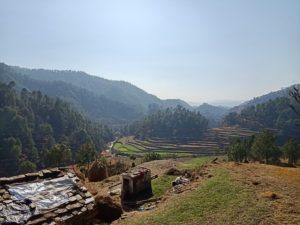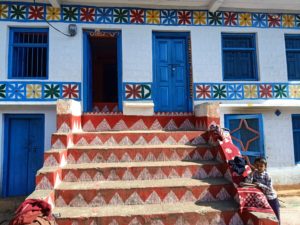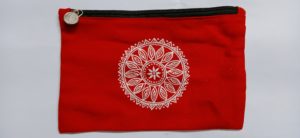Traditionally, eco-feminist theories hold that women are custodians of traditional knowledge. But there is a gap in this theory by not fully exploring the questions of: (1) What is this “knowledge”?; and (2) What is the scope of identifying gender-based knowledge? I work towards answering the latter question throughout this article, but for the first question the answer is rather simplistic. The eco-feminist perspective demonstrates that women’s traditional knowledge is reflected by their skills to maintain a sustainable ecosystem, especially in rural areas. Sustainable skills can include healthy cooking of local foods and practicing seed preservation. But these skills are highly varied and unique to women across different geographical spaces; a fact that emerges from my research with women of Uttarakhand, a state region in northern India.

View of Dhikuli Village, Almora, Uttarakhand
According to a study published by Susanne Wymann von Dach:
“Mountain women possess unique social and collective identities. These differential identities may even vary from valley to valley in the same geographical area.”
To better understand Dach’s argument, I will be discussing two case studies in the Uttarakhand state: “Minakriti: The Aipan Project” (see more on Instagram) and “Namakwali” (see more on Instagram). These projects recognize the unique regional skill displayed by women of art and culinary skill that can only be found in Uttarakhand, India.
The state of Uttarakhand has a stark regional division, namely Kumaon and Garhwal. This division has a vast historical and cultural context and thus, the women of both regions have developed different traditional skills.
Case 1: The Minakriti: Aipan Project
This project is a start-up by a young woman, Minakshi Khati, from Chhoi, a small village in Ramnagar, Nainital District of Uttarakhand. She is trying to revive the Aipan, an age-old traditional art specific to the Kumaon region that also holds religious significance.
Aipan is typically called women’s art because women are the only ones carrying out the cultural traditions of making Aipan on the walls (Dehli), doors (Dwar), windows, and stairways of mud houses. The procedure of making Aipan involves them collecting red ochre soil (Geru) from the forest (jungle) and then drawing (chinas, motifs) symbols with rice paste (Biswar) using their fingers. This art is supposedly used to welcome deities in their home on auspicious events.

Aipan Art on stairs of Bhagwati Behen (Juniyali homestay under Sewa Atithi)
But Minakshi shares her concern, saying that as the rural landscape is rapidly changing (such as a shift from mud houses to brick and concrete houses) with urban culture influencing the rural mountains, the tradition of making art is losing its importance.
Social media as digital storytelling
Thus, she speculated on this initiative to popularize Aipan Art using digital platforms like Facebook, Instagram, and Twitter. She shares that her fascination for art developed at a very young age, and she was inspired to learn Aipan from her grandmother and mother. They were the forerunners passing down the knowledge of Aipan who drew different motives and symbols on walls and doors during religious occasions, which gave Minakshi the idea of expanding and experimenting with the art for its revival.
Her curiosity to learn about art helped her start the Aipan Project in 2019. Thus, her first step was to capture the audience’s attention by posting its significance and history over Facebook. She used the tactic of digital storytelling, and over a year, her business started generating a business of Rs 30,000 to 50,000 monthly. Moreover, she is providing seasonal employment to women of all ages. She has brought the art of walls and doors on paper, wood, and glass. Her product line sells Aipan décor pots, cups, plates, earthen lamps (diyas), wall paintings, bookmarks, etc. And now the art is made using paint and brush, for which she trains women for 30 days before giving them assignment orders.

Aipan drawn on Pencil Box
Additionally, she is also running several drives to educate people about Aipan. She has hosted several offline (Chittai, Almora; Nari Niketan, Kedarpuram; Sewa Kalyan; Mahila Shakti Kendra, Dehradun) and online workshops (especially during the COVID-19 pandemic), which are open to all. Her effort has engaged a population of about 14527 across all social media platforms.
Due to her efforts to revive this art, Minakshi is popularly known as the “Aipan Girl of Uttarakhand.” Her initiative has brought a new direction to art and rejuvenated people’s interest worldwide in Aipan.
Case 2: Namakwali
This project represents another case that used the digital storytelling method to popularise women’s traditional knowledge in culinary arts.
“Namakwali” literally translates as the noun for a “Girl/women with salt.” It is a project developed by Shashi Bahuguna Raturi. Her idea was to use women’s knowledge of cooking as a method of empowerment while spreading awareness about the (Pahadi) Mountain cuisine.
She noticed that the local salt (named “Pisyu Loon”) used daily in the staple cooking included peculiar and local ingredients like cannabis seeds and several other Indigenous ingredients. Thus, she, started this initiative in 2017, where social media, preferably Instagram and Facebook, were used to showcase the different local salts and generate broader interest.
The photos and videos showcased women’s hand-grounding products using “sil batta” (traditional grindstone). Then the posts used captions like “Agr Tata Namak Desh ka namak hai to pisyu loon Uttarakhand Ka” which translates to “If Tata Salt is salt of Nation, then Pisyu loon is the salt of Uttarakhand.” This tagline connects with people because it reflects competition with India’s leading salt company Tata Salt. Furthermore, this project gradually grew to a network of 10-12 women who make a range of salts and spices using cannabis, ginger, mint, coriander, turmeric, garlic, and chili as primary flavors. Using digital storytelling as a primary method of reaching broader audiences, the reach of their market has soared all over India, even to metropolitan cities of Bangalore, Delhi, Mumbai, and Pune.
Connecting sustainable practices of women in Uttarakhand to regional development
Leading from my qualitative analysis of these two case studies, an answer begins to emerge to the second question I posed earlier of identifying the scope of gender-based knowledge. Both initiatives discussed above are run by mountain women: Minakshi Khati and Sashi Raturi. These two women identified and shared the skills of art and culinary arts that are culturally associated with women due to the prevailing patriarchal construct of society. Utilizing social media and digital storytelling as a means of innovation within this context, both case studies demonstrate the potential for generating livelihoods and employment for women.
These cases lay forward the path for recognizing the geographical identity of women for regional development, especially in India, where physiographic division is as complex as its cultural diversity. India has recently created several schemes for regional growth by encouraging start-up businesses, like the TRIFED (Tribal Co-operative Marketing Development Federation) developed Van Dhan Yojana to widen the scope for developing ethnic entrepreneurship. The Van Dhan growth centers are being designed to identify particular tribal skills. Thus, as a way forward and to better bring inclusive development, the above scheme can be explored through the gendered lens, and identifying unique traditional skills of tribal women can bring a more holistic approach to development.
Acknowledgment: I would like to thank Minakshi Khati and Sashi Raturi for their cooperation and participation in the research. And I am also humbly obliged to the University Grant Commission(UGC) for funding the research. And last but not least, I would like to extend my gratitude to Dr. Anjali Kulkarni, who supported me immensely during my study and provided critical inputs for the formation of research.

Lavanya Gupta (Twitter) is a Senior Research Scholar at the Department of Rural Development, Tata Institute of Social Sciences, India
Contact: tp2021rd004@stud.tiss.edu
Mobile number: +91 9580843356
Are you currently involved with regional research, policy, and development? The Regional Studies Association is accepting articles for their online blog. For more information, contact the Blog Editor at rsablog@regionalstudies.org.